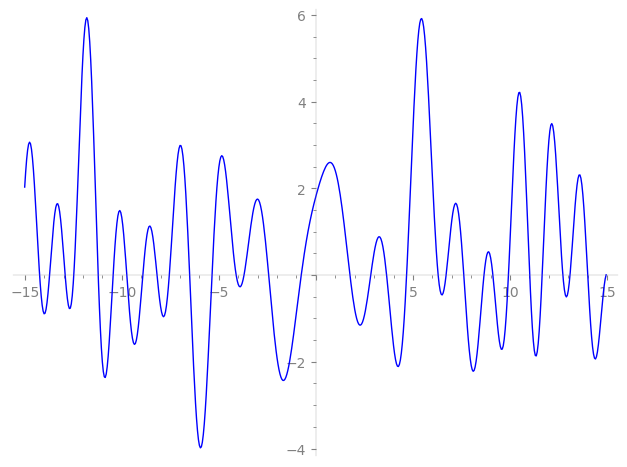| L(s) = 1 | + (1.65 + 0.523i)3-s + (−0.841 − 1.45i)5-s + (−1.65 − 2.06i)7-s + (2.45 + 1.72i)9-s + (0.622 − 1.07i)11-s + (1.96 − 3.39i)13-s + (−0.626 − 2.84i)15-s + (−1.62 − 2.81i)17-s + (−2.36 + 4.09i)19-s + (−1.65 − 4.27i)21-s + (−0.199 − 0.344i)23-s + (1.08 − 1.87i)25-s + (3.14 + 4.13i)27-s + (−3.19 − 5.54i)29-s + 0.578·31-s + ⋯ |
| L(s) = 1 | + (0.953 + 0.302i)3-s + (−0.376 − 0.651i)5-s + (−0.625 − 0.780i)7-s + (0.817 + 0.576i)9-s + (0.187 − 0.325i)11-s + (0.543 − 0.941i)13-s + (−0.161 − 0.735i)15-s + (−0.394 − 0.683i)17-s + (−0.541 + 0.938i)19-s + (−0.360 − 0.932i)21-s + (−0.0415 − 0.0718i)23-s + (0.216 − 0.375i)25-s + (0.604 + 0.796i)27-s + (−0.594 − 1.02i)29-s + 0.103·31-s + ⋯ |
Λ(s)=(=(1008s/2ΓC(s)L(s)(0.294+0.955i)Λ(2−s)
Λ(s)=(=(1008s/2ΓC(s+1/2)L(s)(0.294+0.955i)Λ(1−s)
| Degree: |
2 |
| Conductor: |
1008
= 24⋅32⋅7
|
| Sign: |
0.294+0.955i
|
| Analytic conductor: |
8.04892 |
| Root analytic conductor: |
2.83706 |
| Motivic weight: |
1 |
| Rational: |
no |
| Arithmetic: |
yes |
| Character: |
χ1008(625,⋅)
|
| Primitive: |
yes
|
| Self-dual: |
no
|
| Analytic rank: |
0
|
| Selberg data: |
(2, 1008, ( :1/2), 0.294+0.955i)
|
Particular Values
| L(1) |
≈ |
1.819168600 |
| L(21) |
≈ |
1.819168600 |
| L(23) |
|
not available |
| L(1) |
|
not available |
L(s)=p∏Fp(p−s)−1 | p | Fp(T) |
|---|
| bad | 2 | 1 |
| 3 | 1+(−1.65−0.523i)T |
| 7 | 1+(1.65+2.06i)T |
| good | 5 | 1+(0.841+1.45i)T+(−2.5+4.33i)T2 |
| 11 | 1+(−0.622+1.07i)T+(−5.5−9.52i)T2 |
| 13 | 1+(−1.96+3.39i)T+(−6.5−11.2i)T2 |
| 17 | 1+(1.62+2.81i)T+(−8.5+14.7i)T2 |
| 19 | 1+(2.36−4.09i)T+(−9.5−16.4i)T2 |
| 23 | 1+(0.199+0.344i)T+(−11.5+19.9i)T2 |
| 29 | 1+(3.19+5.54i)T+(−14.5+25.1i)T2 |
| 31 | 1−0.578T+31T2 |
| 37 | 1+(−2.72+4.71i)T+(−18.5−32.0i)T2 |
| 41 | 1+(−4.20+7.27i)T+(−20.5−35.5i)T2 |
| 43 | 1+(2.46+4.26i)T+(−21.5+37.2i)T2 |
| 47 | 1−0.425T+47T2 |
| 53 | 1+(0.466+0.807i)T+(−26.5+45.8i)T2 |
| 59 | 1+6.05T+59T2 |
| 61 | 1−10.2T+61T2 |
| 67 | 1−9.41T+67T2 |
| 71 | 1+8.46T+71T2 |
| 73 | 1+(−6.82−11.8i)T+(−36.5+63.2i)T2 |
| 79 | 1−5.53T+79T2 |
| 83 | 1+(−8.03−13.9i)T+(−41.5+71.8i)T2 |
| 89 | 1+(6.03−10.4i)T+(−44.5−77.0i)T2 |
| 97 | 1+(5.86+10.1i)T+(−48.5+84.0i)T2 |
| show more | |
| show less | |
L(s)=p∏ j=1∏2(1−αj,pp−s)−1
Imaginary part of the first few zeros on the critical line
−9.740902613154469337156284394711, −8.914269941538164361099730955157, −8.183345473213814923090382406114, −7.55087930098286333910318775843, −6.50242785489621386845902393844, −5.35284194845050011067065628181, −4.10660791421427195389284238942, −3.70258499917188875707760265364, −2.43276302136549163859671483709, −0.75508256751896699185577131204,
1.75401866983436407903183279035, 2.82466862415444116067458929697, 3.64159604929253198430355184744, 4.67177886367156031860706751673, 6.29713443057348450164217093368, 6.70596029091311366504029906405, 7.61733036382599719782757000518, 8.658095905773061853296731383744, 9.116146796148702541377311418105, 9.918319363017319730932483752496

